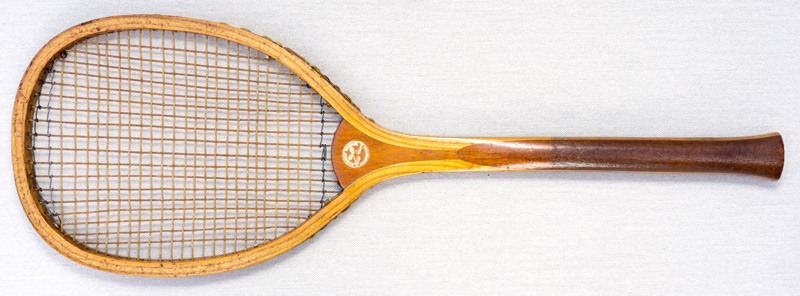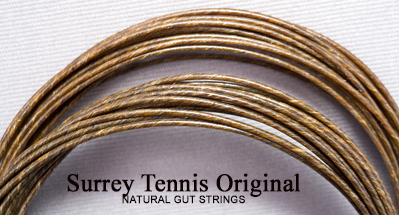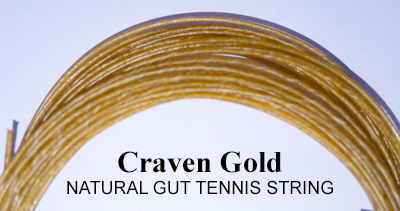|
Henry Joseph Craven was born on 16th April 1854
in Wrexham, Denbighshire Wales, the son of Henry and Sarah Craven. He served
his apprenticeship as an iron moulder but in 1872 gave up this trade and started a
hardware business which also sold paraffin oil, sports goods and he provided
racket stringing service. Natural Gut String was supplied to Henry by
Heymans of Finsbury Square, London. A couple of years later garden
tennis and badminton sets became very popular with customers and Henry started
hand making rackets.
SURREY TENNIS
Surrey Tennis is now one of the oldest family businesses in Europe.
In 1874 a business opportunity arose through Heymans providing a mobile racket stringing service in Surrey. The
stringing room was situated on the Reigate Road (now the A217) at Burgh Heath and
was managed by
Henry's his assistant, Joseph Ward. During Summer weekends a regular
mobile stringing service (by bicycle) was provided at the croquet lawns of Woodcote
House, Epsom, Reigate Priory, Redhill and the Nork Park Estate. The stringing service included badminton (battledore),
garden (lawn) and court (real) tennis rackets. The first strings used by
Surrey Tennis were made from goat intestines. In the stringing room, string
was always called "goaty" even when it was made from other animals.
Goat and sheep gut although more elastic became more expensive than cattle
gut and it was found by making cattle gut slightly thinner, it produced the
same performance for playing garden tennis. The 15 gauge string was also used for
trebling until the thinner strings became popular. The brownish string
(Surrey Tennis Original) remains almost unchanged to present day.
EARLY RACKET STRINGING
Whilst many players are enthusiastic about rackets, the type of string used
and when it should be replaced is often forgotten. The natural gut string
has been used in rackets for hundred years and is still used by many
professionals keeping itís elasticity better than any synthetic string made
today. In the early days of garden tennis and badminton (battledore)
there were no established methods of stringing and it was often left to the
individual stringers on how they would restring a racket. The racket to be
strung was secured in a vice or clamp. Henry Craven would use a Roll which
resembled a wooden hammer wrapped in leather to tighten strings. Once the
string was at the correct tension which was confirmed by the sound when
plucking the string, a wood pin or an awl was inserted into the hole to hold
the tension. In the early days of racket stringing it was normal to replace
just the broken or damaged strings in a racket. Strings were joined and
secured using invisible knot methods.
1872 SURREY
TENNIS 3-9 STRINGING PATTERN
In 1872 Henry invented a stringing pattern that is still used at Surrey
Tennis to this day. The standard 3 to 9 pattern used on many wood rackets
was tensioned in the normal way using a roll and awl or pin by hand. The
first 6 centre strings are strung first. Both the 3 mains after tensioned
are then run up the outside of the racket to the 9th mains holes and then
strung and tensioned back to the centre: 8, 7, 6, 5, and 4. There is no loss
of tension using this method and the loops on some other stringing methods
are not required. It is important that the 4th main strings are tied off or
secured before starting on the crosses so that an awl is not knocked by
mistake loosing tension on the main strings.
RACKET MAKING
Henry Craven has sometimes been described as a tennis racket manufacturer.
This is not quite correct. His enthusiasm came from playing tennis and
hand making and designing rackets which he sold in small quantities to
players, tennis clubs, sports shops and department stores in London. He
experimented with different designs giving many rackets to friends and
family abroad. He also tried producing a few metal rackets, but the weight
of them prevented them from being an alternative to wood. Several of his
handmade rackets had an adjustment feature to release the tension of the
strings after play. His "Adjustable" Racket was later manufactured in a
similar design by several members of his family living abroad. The
"Adjustable" became popular in the early 1900s in the
USA. Henry and Joseph personally hand crafted many rackets from 1874 to 1910 for other
sports shops and London department stores including the
Army and Navy Stores, Browne and Heppell Sports and later for A. W. Gamage
and partners. His assistant, Joseph Ward also made some rackets for
the business at the Burgh Heath Blacksmiths during the Winter months when
the stringing business was quiet. Henry's first rackets in 1874 were transitional flat-tops, later called
the "Surrey".
THE SURREY RACKET
The Surrey Racket originally made with a regular handle, made from 1874 and
from 1876 unbranded for London shops. The 15 gauge natural gut string at
this time was used for the trebling. After 1880 the trebling had changed to
thin black natural gut and later to a raspberry (dark red colour) still made
today. A racket
with a leather grip was produced as a special edition in 1884 and was sold
at the Wimbledon tournament in the same year. In the 1880s some "Surrey" Rackets were
made with fantails and branded the "The Club". (PHOTO BELOW). Rackets were supplied blank to shops
so that the retailer could put their own name brand to the racket. By 1900
the Surrey had changed to an oval frame and sold in shops under numerous
names and some were made with a conventional fishtail handle. Coloured
strings had become popular and a raspberry string was often used for either
the mains or the cross strings. A few rackets were also produced with double
main strings in the centre.

(Above) THE SURREY CLUB 1880s fantail,
transitional flat-top with the Surrey Tennis logo on the wedge
THE WINDERMERE
The Windermere Racket was a Fish Tailed Racket. ( It has no connection with
the Spalding racket with the same name) The wood handle was engraved with
fish scales giving a good grip. The workshop log book indicated that 14 of
these rackets were made. One was sent to the Craven family in Australia
around 1905 and others sold. The racket was marked on the neck with
Windermere on one side and an image of a fish on the other. In 1989, one of
these rackets was sold for £1250 to a private collector.
THE END OF HAND MADE RACKET MAKING
By 1910 the days of the small racket maker had come to an end and Henry's
racket making workshop closed down. Rackets had become to be manufactured by
large companies at competitive prices and these were sold in his shop
together with other sports goods including bowls. In 1912 Henry had 3 racket stringers working full time, one at his hardware shop
and two at the Surrey Tennis stringing room at Reigate Road, Burgh Heath,
(Now called the Brighton Road A217). Henry retired in 1918 at the
age of 64 leaving the shares in his business to his 10 children and
he continued playing garden tennis, (later known as Lawn tennis), into his 80s.
NATURAL GUT TENNIS STRINGS
The success of the racket and stringing business was partly due to Heymans
of Finsbury Square, London, who first supplied the Craven family with some of the
finest imported gut strings. By 1876 the cost of imported tennis string was
becoming too expensive and Henry Craven started producing his own string in
England. This string is still produced and sold today in small quantities
for the restoration of wood tennis rackets.
1. "THE SURREY TENNIS ORIGINAL" (Heymans Brown) was the original string
produced in 15 gauge. It was a popular string throughout the 19th century.
2. "CRAVEN GOLD" This string was first produced in 1876 to match the
colouring of the varnished wood frames, 15.5 gauge. It has a golden
appearance and is finely polished giving a smoother appearance and used to
restring 19th and 20th century wood rackets.
3. "THE RASPBERRY" This is similar to the Craven Gold with the
addition of the burgundy colouring added. Popular in rackets from 1890 to
1950.
4. BLACK & RASPBERRY TREBLING This was a thin natural gut string produced in
either black or raspberry colour. It is about the same thickness as a modern
badminton string. Very popular from 1890 to 1960. Around 1960 trebling
started to be made using synthetic strings.
 
MEGGIE CRAVEN
Henry's daughter, Meggie, was the backbone of the business. From an early age
she kept the business accounts, worked in the store and strung rackets. At a
racket stringing contest held at a local croquet club she won the
competition for re-stringing a racket with trebling in the fastest time,
just 37.5 minutes. The men in the competition could only achieve the
shortest time of 42 minutes.
STRINGING ROOMS
Henry took over the running of Surrey Tennis in 1874 which was situated by
the Reigate Road, Burgh Heath. The business later moved to The Green at
Burgh Heath near to the
fish ponds and tea rooms. Customers could partake in tea and cake whilst waiting
for their racket to be strung. Two bicycles were fitted out to hold
stringing tools providing a mobile service to customers, croquet lawns and
later tennis clubs. The business at Burgh Heath was in an ideal position for
selling rackets to department stores and sports shops in London, being on a
direct coach route to London and later close
to the S R Chipstead Valley Branch Line. It was also situated close to many
of the gardens and croquet lawns where garden tennis was played. The
stringing room remained on The Green until 1959 when it moved to Colcokes Road, Banstead. Henry's grandson, John, a medical practitioner,
became the tennis player of the family taking part in many tournaments from
the 1930s to 50s. Henry's great grandson, Philip, learnt how to restring
rackets at the age of 9 years and later became a tennis professional in
1968. Surrey Tennis moved to a purpose built studio
near Epsom Downs in 1974 providing a stringing service for Banstead Sports and
Seymour sports shops in Epsom and Dorking. The racket stringing workshop
moved to Leatherhead in 2021.
SURREY TENNIS TODAY
The business continues providing a fast local stringing service, tournament
stringing and specialises in the purchase, sale and restoration of wood rackets
for collectors, museums
and film companies. Natural gut tennis strings are still produced and sold
in small quantities for antique rackets. During recent years there have been
considerable advances in stringing technology. Stringing equipment is now
accurate to a 1/10 lb. After we string a racket the string bed is tested and
afterwards a computer reading is made for the Dynamic Tension, enabling the
player to know when the racket needs restringing. A 2 hour stringing service
is provided at Leatherhead. |
![]()